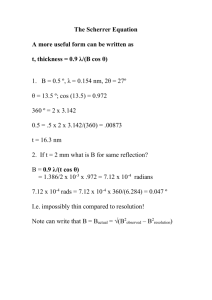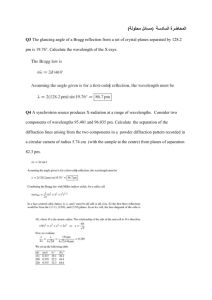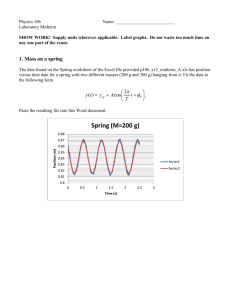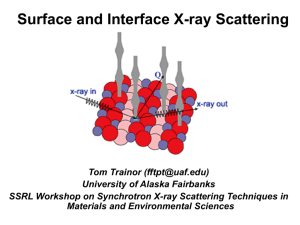مقرر اختياري – المرحلة الثالثة
advertisement
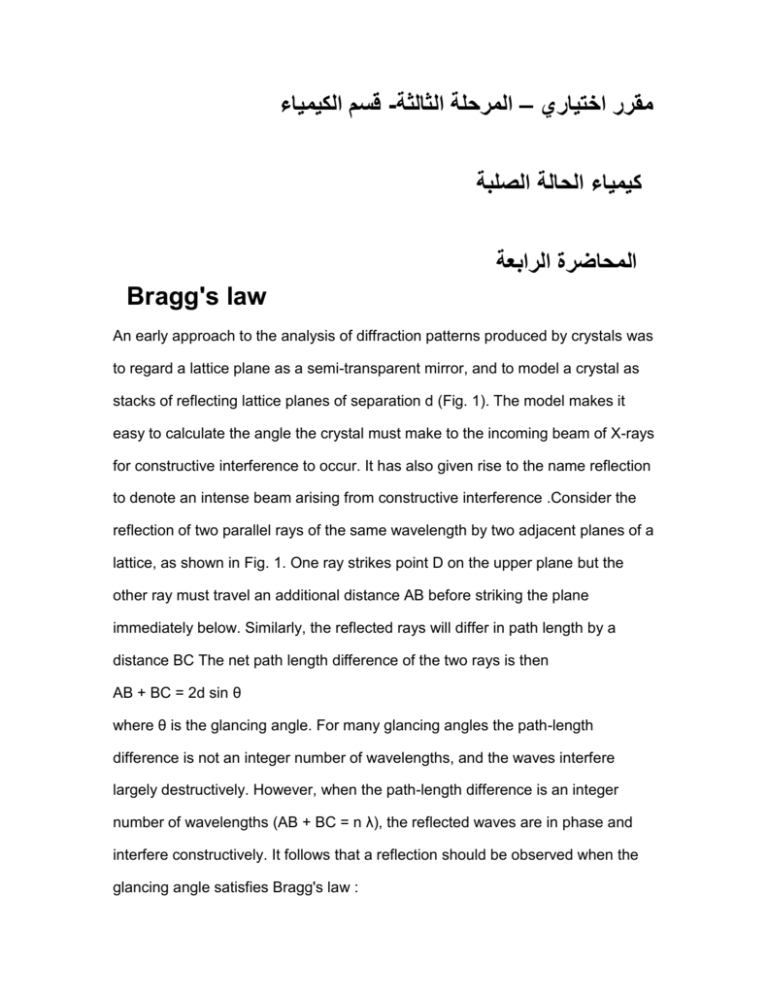
قسم الكيمياء-مقرر اختياري – المرحلة الثالثة
كيمياء الحالة الصلبة
المحاضرة الرابعة
Bragg's law
An early approach to the analysis of diffraction patterns produced by crystals was
to regard a lattice plane as a semi-transparent mirror, and to model a crystal as
stacks of reflecting lattice planes of separation d (Fig. 1). The model makes it
easy to calculate the angle the crystal must make to the incoming beam of X-rays
for constructive interference to occur. It has also given rise to the name reflection
to denote an intense beam arising from constructive interference .Consider the
reflection of two parallel rays of the same wavelength by two adjacent planes of a
lattice, as shown in Fig. 1. One ray strikes point D on the upper plane but the
other ray must travel an additional distance AB before striking the plane
immediately below. Similarly, the reflected rays will differ in path length by a
distance BC The net path length difference of the two rays is then
AB + BC = 2d sin θ
where θ is the glancing angle. For many glancing angles the path-length
difference is not an integer number of wavelengths, and the waves interfere
largely destructively. However, when the path-length difference is an integer
number of wavelengths (AB + BC = n λ), the reflected waves are in phase and
interfere constructively. It follows that a reflection should be observed when the
glancing angle satisfies Bragg's law :
n λ.= 2d sin θ
Reflections with n = 2, 3,…… are called second-order, third-order, and so on;
they correspond to path-length differences of 2, 3, . …, wavelengths. In modern
work it is normal to absorb the n into d, to write the Bragg law as
λ.= 2d sin θ
and to regard the nth-order reflection as arising from the {nh,nk,nl} planes
The primary use of Bragg's law is in the determination of the spacing between
the layers in the lattice for, once the angle corresponding to a reflection has
been deter- mined, d may readily be calculated.
Fig. 1 The conventional derivation of Bragg's law treats each lattice plane
as a reflecting the incident radiation. The path lengths differ by AB + BC,
which depends on the glancing angle, θ. Constructive interference (a
'reflection') occurs when AB + BC is equal to an integer number of
wavelengths.
Example 1 Using Bragg's law
A first -order reflection from the {Ill} planes of a cubic crystal was observed at a
glancing angle of 11.2 0 when Cu(Kα ) X-rays of wavelength 154 pm were used.
What is the length of the side of the unit cell?
Answer
The {III} planes responsible for the diffraction have separation
d111 = λ / 2 sin θ
The separation of the {Ill} planes of a cubic lattice of side a is given by
d111 = a / 31/2
Therefore,
a = 31/2 λ / 2 sin θ = 31/2 x (154 pm) / 2 sin 11.20 = 687 pm
Self-test 1 Calculate the angle at which the same crystal will give a reflection
from the {123} planes. [24.80].
Some types of unit cell give characteristic and easily recognizable patterns of
lines. For example, in a cubic lattice of unit cell dimension a the spacing is given
so the angles at which the {hkl} planes give first-order reflections are given by
sin θ = (h2 + k 2 + I2)1/2 λ / 2a
The reflections are then predicted by substituting the values of h, k, and I:
{hkl}
h2 + k 2 + I2
.
{100} {1l0} {Ill} {200} {210} {21l} {220} {300} {221} {310}...
1
2
3
4
5
6
8
9
9
10 . .
Notice that 7 (and 15, . . .) is missing because the sum of the squares of three
integers cannot equal 7 (or 15, . . .). Therefore the pattern has absences that are
characteristic of the cubic P lattice.
Self-test 2 Normally, experimental procedures measure 2 θ rather than θ itself.
A diffraction examination of the element polonium gave lines at the following
values of 2θ (in degrees) when 71.0 pm Mo X-rays were
used:12.1,17.1,21.0,24.3, 27.2, 29.9, 34.7, 36.9, 38.9, 40.9, 42.8. Identify the unit
cell and determine its dimensions. [cubic P; a = 337 pm].
Scattering factors
To prepare the way to discussing modern methods of structural analysis we need
to note that the scattering of X-rays is caused by the oscillations an incoming
electromagnetic wave generates in the electrons of atoms, and heavy atoms give
rise to stronger scattering than light atoms. This dependence on the number of
electrons is expressed in terms of the scattering factor, f, of the element. If the
scattering factor is large, then the atoms scatter X-rays strongly. The scattering
factor of an atom is related to the electron density distribution in the atom, Ρ(r),
by
The value of f is greatest in the forward direction and smaller for directions away
from the forward direction (Fig. 2). The detailed analysis of the intensities of
reflections must take this dependence on direction into account (in single crystal
studies as well as for powders). We show in the Justification below that, in the
forward direction (for θ = 0), f is equal to the total number of electrons in the
atom.
The variation of the scattering factor of atoms and ions with atomic number
and angle.
